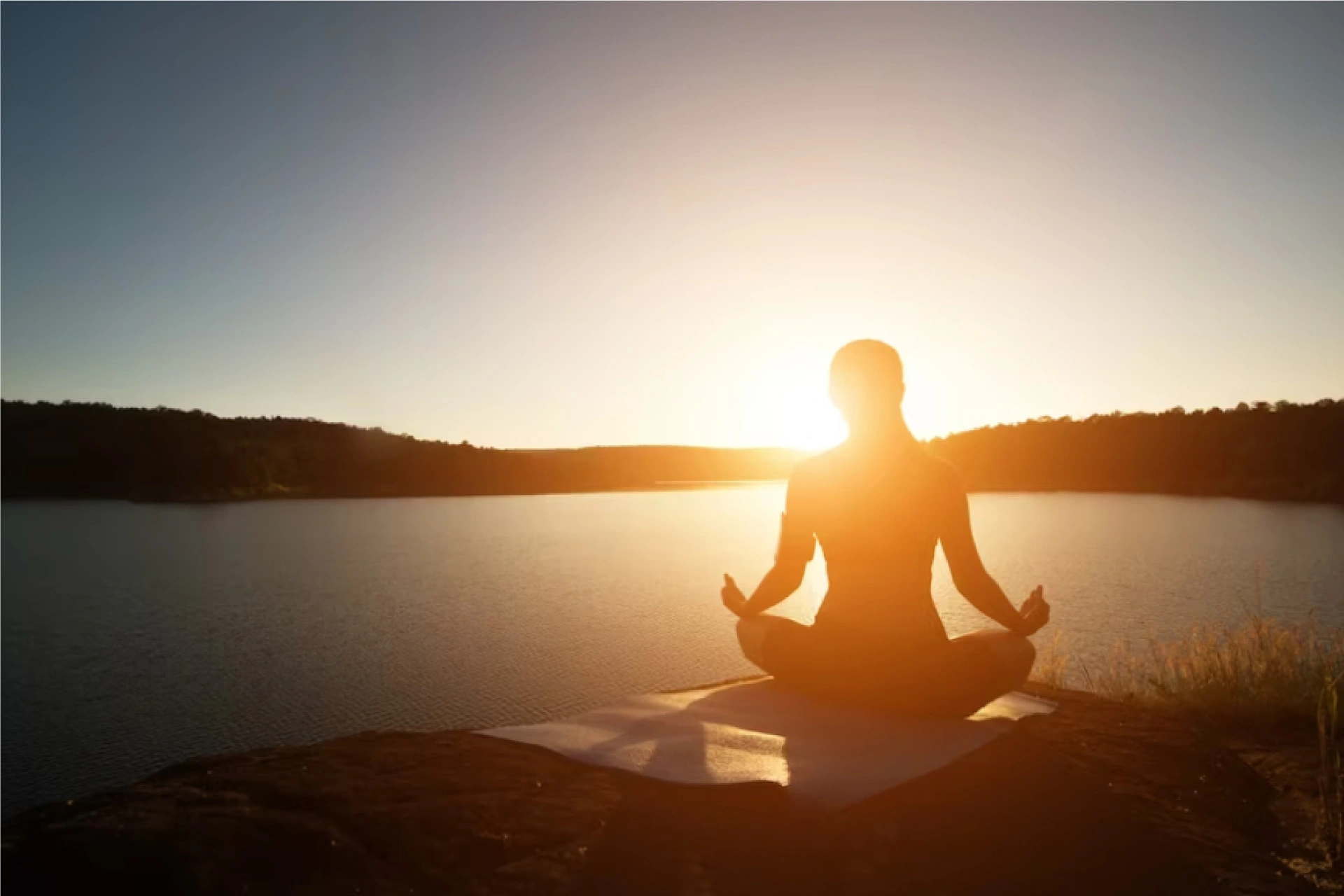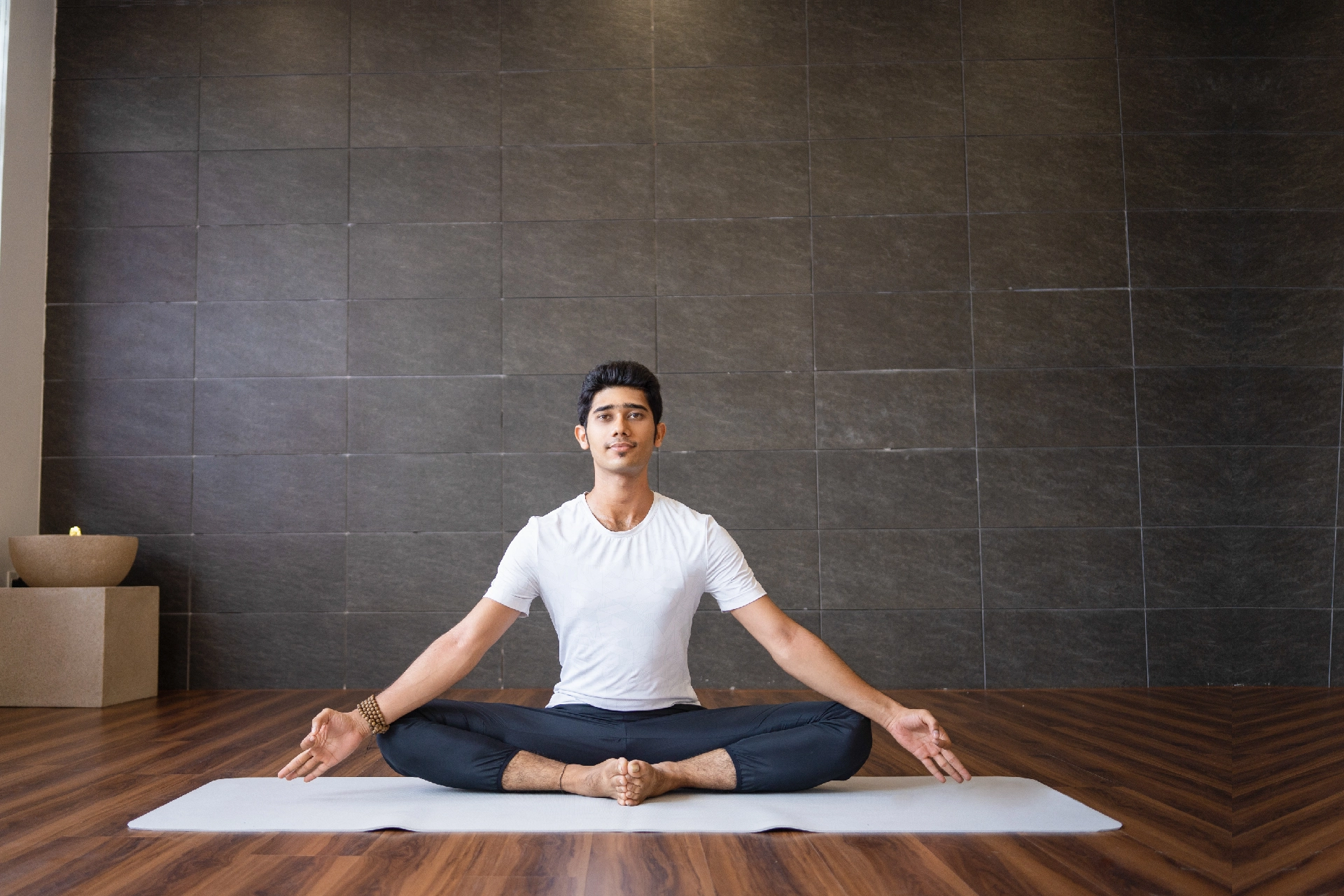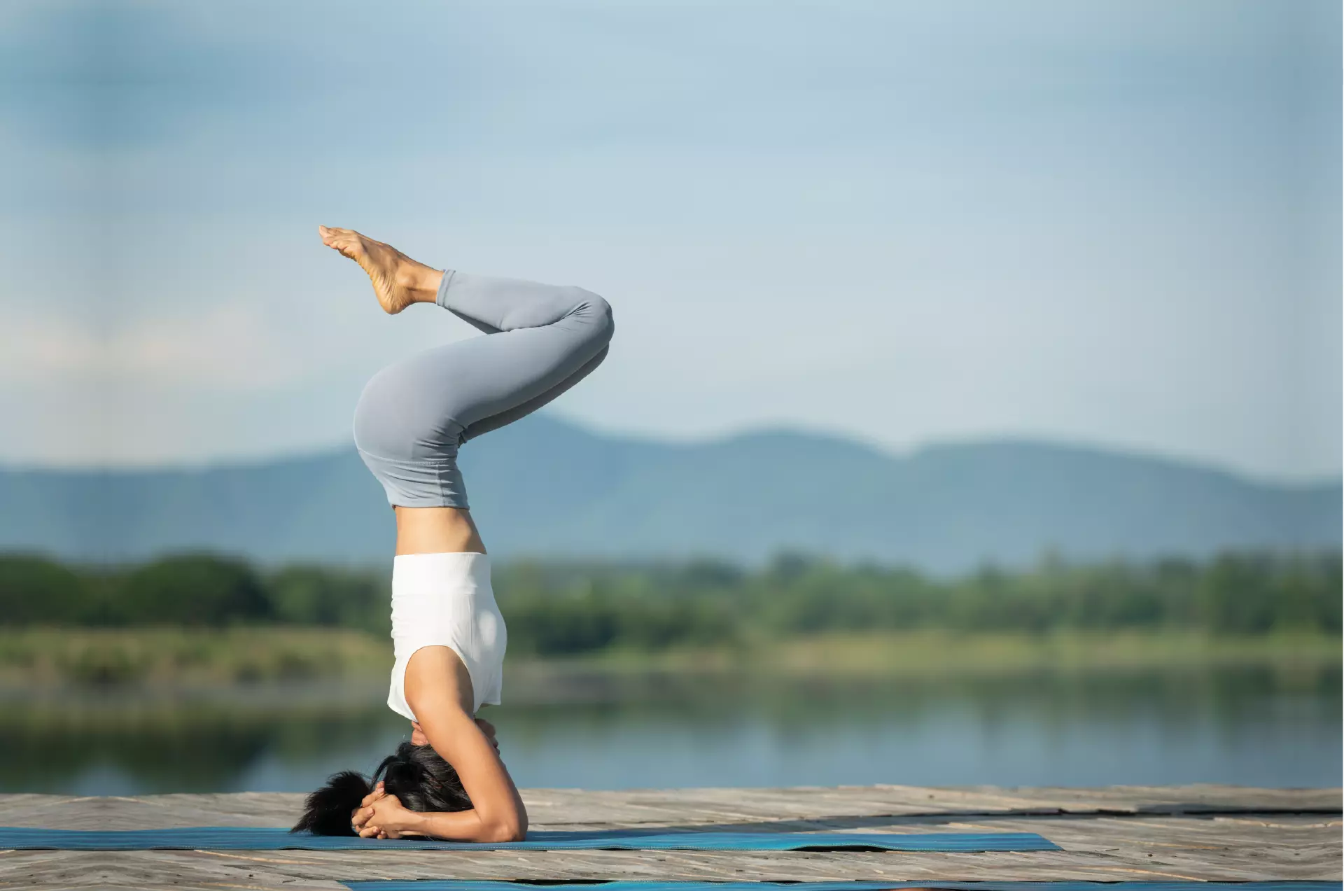Yoga & Exercise | min read
10 Yoga for Diabetes to Improve Insulin Sensitivity
Medically reviewed by
Table of Content
Synopsis
Yoga is an ancient practice that has been proven to be beneficial for managing various health conditions, including diabetes. Regular yoga can improve insulin sensitivity, reduce stress, and promote well-being. This blog will discuss the ten best yoga asanas that can help manage diabetes.
Key Takeaways
- Yoga asanas can improve insulin sensitivity and help manage diabetes
- Tadasana, also known as the Mountain Pose, helps to improve posture and reduce stress
- Beginners can practice yoga for diabetes, but it is important to start with simple poses and gradually work up
Doing yoga for diabetes management could be one of the best ways to manage the condition. Yoga is a traditional practice that originated in ancient India and has been followed for thousands of years. It involves physical postures, breathing techniques, and meditation, all of which can promote overall health and well-being. One of the many benefits of yoga asanas for diabetes is their ability to manage diabetes by improving insulin sensitivity. This blog will discuss the ten best yoga asanas that can help manage diabetes.
10 Best Yoga Asanas for Diabetes
Yoga exercise for diabetes has proven to be effective in managing diabetes and improving insulin sensitivity. Here is yoga for diabetes that you can try:
1. Tadasana (Mountain pose)
Benefits: Improves posture, strengthens legs, and reduces stress and is a good yoga for diabetes
Tadasana, also known as the Mountain Pose, is a standing pose that helps to improve posture, strengthen the legs, and reduce stress. This pose is often used as a starting point for other yoga poses.
How to perform: To perform Tadasana, yoga for diabetes, stand with your feet together and distribute your weight evenly on both feet. Inhale and lift your arms up towards the ceiling, and bring your palms together. Gently stretch your spine upward and look straight ahead. Hold the Tadasana pose for a few breaths before releasing.
Precautions to take: Avoid this pose if you have high blood pressure or migraine. If you have low blood pressure, be cautious when rising from this pose, as it can cause dizziness.
2. Vrikshasana (Tree pose)
Benefits: This yoga for diabetes improves balance, strengthens legs, and reduces stress
Vrikshasana, also known as the Tree Pose, is a balancing pose that improves balance, strengthens the legs, and reduces stress. This yoga for diabetes requires focus and concentration, which helps to calm the mind.
How to perform: To perform Vrikshasana, stand with your feet together and lift your right foot off the ground. Next, place your right foot on your left thigh, and bring your palms to your chest. Now, focus your gaze on a point in front of you, and hold the pose for a few breaths before releasing and repeating on the other side. Try this yoga for diabetes every day.
Precautions to take: Be careful not to place your foot on your knee joint, as this can cause injury. Avoid raising your arms above your head if you have high blood pressure.
Additional Read: Home Remedies for Diabetes
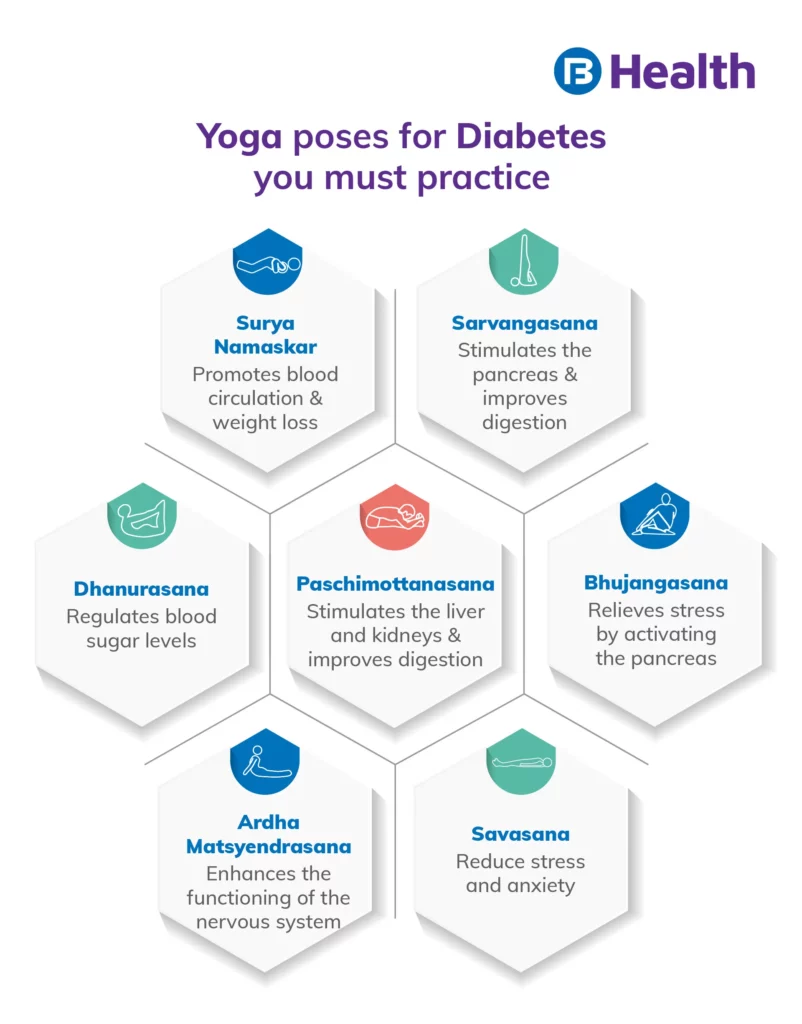
3. Trikonasana (Triangle pose)
Benefits: This yoga for diabetes stretches the spine and improves digestion
Trikonasana, also known as the Triangle Pose, is a standing pose that stretches the spine and improves digestion. This pose also helps to strengthen the legs and opens up the hips.
How to perform: To perform Trikonasana, stand with your feet wide apart, extend your arms out to the sides, and bend sideways to touch your right foot with your right hand. Keep your left arm stretched towards the ceiling, and look up towards your left hand. Hold this asana for a few breaths before releasing and repeating it on the other side.
Precautions to take: Avoid this pose if you have low blood pressure, diarrhoea, or headache. Avoid looking up towards your raised hand if you have neck or spine problems. This is good yoga for diabetes, but if you have any health conditions listed above, please avoid this asana.
4. Ardha Matsyendrasana (Half lord of the fishes pose)
Benefits: Massages internal organs, improves digestion, and reduces stress
Ardha Matsyendrasana, also known as the Half Lord of the Fishes Pose, is a seated pose that massages the internal organs, improves digestion, and reduces stress. This pose also helps to stretch the spine and increase flexibility in the hips and shoulders.
How to perform: To perform Ardha Matsyendrasana, sit with your legs stretched out towards the front. Bend your right knee and then place your right foot outside your left knee. Next, twist your torso to the right and push your left elbow towards the outside of your right knee. Hold this yoga pose for a few breaths before releasing and repeating the same on the other side.
Precautions to take: If you have a spinal injury, practice this pose cautiously and avoid twisting too deeply. Individuals with high or low blood pressure should avoid this pose.
Additional Read: Importance of Yoga
5. Paschimottanasana (Seated forward bend)
Benefits: This yoga for diabetes stretches the hamstrings and lower back, improves digestion, and reduces stress
Paschimottanasana, also known as the Seated Forward Bend, is a seated pose that stretches the hamstrings and lower back, improves digestion, and reduces stress. This pose also helps to calm the mind and relieve anxiety.
How to perform: To perform Paschimottanasana, try sitting with your legs stretched out towards the front. Then, lift your arms up towards the ceiling, exhale, and bend forward to touch your toes. Hold this yoga pose for a few breaths before releasing it.
Precautions to take: Avoid this pose if you have a herniated disc or lower back injury. If you have high blood pressure, practice this pose with your head raised or with support.
6. Bhujangasana (Cobra pose)
Benefits: Strengthens the back muscles and improves posture
Bhujangasana, also known as the Cobra Pose, is a backbend that strengthens the back muscles and improves posture. This pose also helps to stretch the chest and shoulders and increase flexibility in the spine.
How to perform: To perform Bhujangasana, lie on your stomach with your palms towards the floor beside your chest. Inhale and lift your head and chest up towards the ceiling using your back muscles. Try keeping your elbows close to your body and hold this yoga pose for a few breaths before releasing.
Precautions to take: Avoid this pose if you have a herniated disc or back injury. If you have been medically diagnosed with carpal tunnel syndrome or wrist pain, avoid putting pressure on your hands.
7. Dhanurasana (Bow pose)
Benefits: This yoga for diabetes stretches the entire body, improves digestion, and reduces stress
Dhanurasana, also known as the Bow Pose, is a backbend that stretches the entire body, improves flexibility, and strengthens the back muscles. This pose also helps to stimulate the internal organs and improve digestion.
How to perform: To perform Dhanurasana, try lying on your stomach with your arms at the sides. Now, bend your knees and bring your heels towards your buttocks. Try to reach back with your hands and grab your ankles. Next, Inhale and lift your head, chest, and thighs off the ground using your back muscles. Hold the pose for a few breaths before releasing.
Precautions to take: If you have a neck or back injury, avoid this pose or practice with caution. Pregnant women and those with hernia or high blood pressure should avoid this pose.
8. Chakrasana (Wheel pose)
Benefits: Chakrasana (Wheel Pose) helps to strengthen the spine, arms, and wrists while improving flexibility and stimulating the nervous system.
Chakrasana, also known as the Wheel Pose, is a backbend that strengthens the back muscles, opens up the chest and shoulders, and improves flexibility. This pose also helps to stimulate the thyroid gland and boost the immune system.
How to perform: To perform Chakrasana, try lying on your back with your knees bent and your feet hip-distance apart. Now, place your hands on the floor beside your head, with your fingers pointing towards your shoulders. Next, try inhaling and lifting your hips up towards the ceiling (top), pressing into your hands and feet. Hold the yoga pose for a few breaths before releasing it.
Precautions to take: Avoid this pose if you have a back injury, carpal tunnel syndrome, or wrist pain. If you have high blood pressure, practice this pose cautiously and avoid holding it for too long.
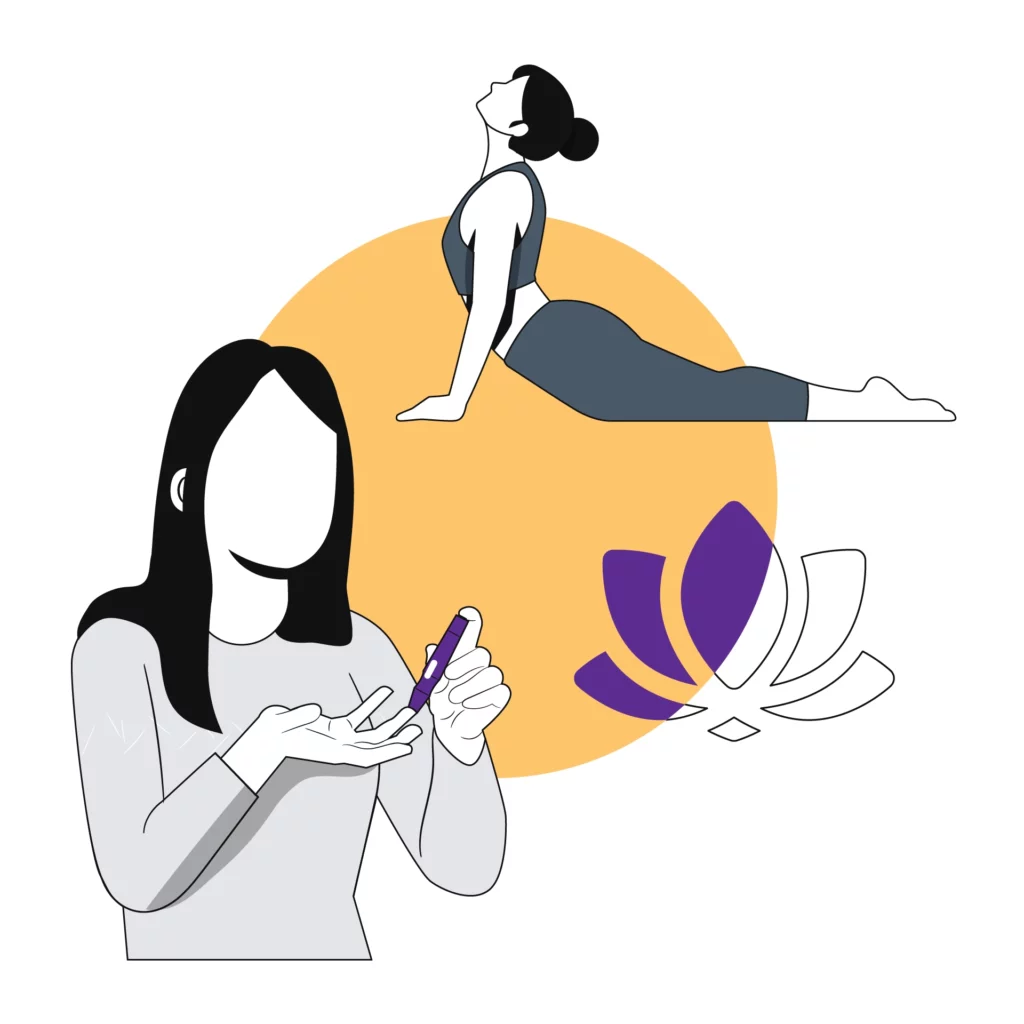
9. Setu Bandhasana (Bridge pose)
Benefits: Stretches the spine, opens the chest, and improves digestion
Setu Bandhasana, also known as the Bridge Pose, is a backbend that strengthens the back muscles, opens up the chest and shoulders, and improves digestion. This pose also helps to relieve stress and anxiety.
How to perform: To perform Setu Bandhasana, try lying on your back and then bend your knees and keep your feet hip-distance apart. Now, place your hands on the floor beside your hips. Inhale generously and lift your hips up towards the ceiling, pressing into your feet. Hold the pose for a few breaths before releasing.
Precautions to take: Avoid this pose if you have a neck or back injury. If you have been diagnosed with low BP, be cautious when rising from this pose, as it can cause dizziness.
10. Shavasana (Corpse pose)
Benefits: Promotes relaxation, reduces stress, and promotes overall well-being
Shavasana, also known as the Corpse Pose, is a relaxation pose that helps to reduce stress, anxiety, and fatigue. This pose also helps to improve concentration and mental clarity.
How to perform: To perform Shavasana, lie on your back with your legs and arms relaxed. Now try closing your eyes and take slow, deep breaths. Allow your body to relax completely and release any tension or stress. Hold the pose for a few minutes before slowly sitting up.
Precautions to take:
- Avoid this pose if you have a spinal injury
- If you are pregnant, practice this pose with your head and chest elevated or on your side
- Keep your body warm during this pose, as it can cause your body temperature to drop
Additional Read: Yoga for heart health
In conclusion, practicing yoga can effectively manage diabetes and improve insulin sensitivity. However, it's important to remember that it should complement traditional medical treatments, not replace them. Regular check-ups and consultations with a general physician are crucial for monitoring your condition. Bajaj Finserv Health allows you to schedule online appointments and consult general physicians easily. Utilize these resources alongside a regular yoga practice to manage your diabetes and live healthier.
Frequently Asked Questions
References
Disclaimer
Please note that this article is solely meant for informational purposes and Bajaj Finserv Health Limited (“BFHL”) does not shoulder any responsibility of the views/advice/information expressed/given by the writer/reviewer/originator. This article should not be considered as a substitute for any medical advice, diagnosis or treatment. Always consult with your trusted physician/qualified healthcare professional to evaluate your medical condition. The above article has been reviewed by a qualified doctor and BFHL is not responsible for any damages for any information or services provided by any third party.
